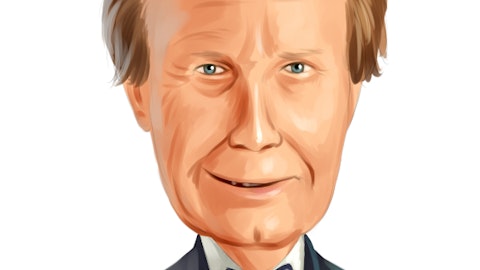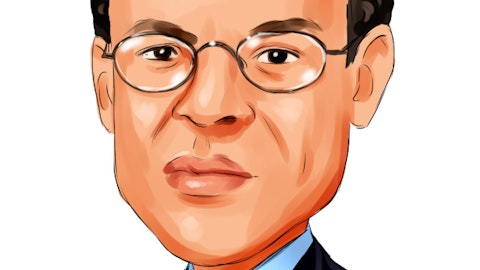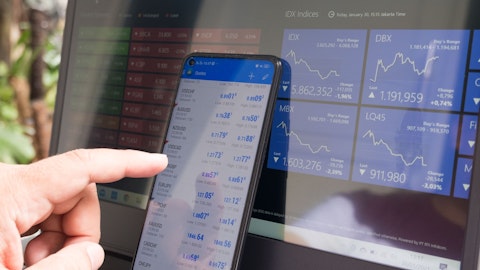Evercore Inc. (NYSE:EVR) Q4 2022 Earnings Call Transcript February 1, 2023
Operator: Good day and welcome to the Evercore Fourth Quarter and Full Year 2022 Earnings Conference Call. Today’s call is scheduled to last about one hour, including remarks by Evercore management and the question-and-answer session. I will now turn the call over to Katy Haber, Managing Director of Investor Relations and ESG at Evercore. Ma’am, please, begin.
Katy Haber: Thank you, (ph). Good morning, and thank you for joining us today for Evercore’s fourth quarter and full year 2022 financial results conference call. I’m Katy Haber, Evercore’s Head of Investor Relations and ESG. Joining me on the call today is John Weinberg, our Chairman and CEO; and Celeste Mellet, our CFO. After our prepared remarks, we will open up the call for questions. Earlier today, we issued a press release announcing Evercore’s fourth quarter and full-year 2022 financial results. Our discussion of our results today is complementary to the press release which is available on our website at evercore.com. This conference call is being webcast live in the For Investors section of our website, and an archive of it will be available for 30 days beginning approximately one hour after the conclusion of this call.
During the course of this conference call, we may make a number of forward-looking statements. Any forward-looking statements that we make are subject to various risks and uncertainties and there are important factors that could cause actual outcomes to differ materially from those indicated in these statements. These factors include but are not limited to those discussed in Evercore’s filings with the SEC, including our annual report on Form 10-K, quarterly reports on Form 10-Q, and current reports on Form 8-K. I want to remind you that the company assumes no duty to update any forward-looking statements. In our presentation today, unless otherwise indicated, we will be discussing adjusted financial measures, which are non-GAAP measures that we believe are meaningful when evaluating the company’s performance.
For detailed disclosures on these measures and the GAAP reconciliations, you should refer to the financial data contained within our press release which is posted on our website. We continue to believe that it is important to evaluate Evercore’s performance on an annual basis. As we have noted previously, our results for any particular quarter are influenced by the timing of transaction closings. I will now turn the call over to John.
John Weinberg: Thank you, Katy. And good morning, everyone. 2022 was undoubtedly a complex and challenging environment. Yet through all of the volatility and macro-driven headwinds, Evercore was able to serve our clients and strategically invest in our business. We continued to perform well, both in the quarter and for the full year. In fact, 2022 was our second best year on record for the firm with $2.8 billion in revenue, $529 million in net income, and $12.1 in earnings per share. For the full year and fourth quarter, we also made further progress on our goal of narrowing the gap between Evercore and the top three bulge bracket firms in terms of advisory fees. 2022 also marked a year of investment for Evercore as we continued to execute on our long-term growth strategy.
We promoted and hired A-plus talent in our important strategic target areas that will drive long-term value for the firm, including seven advisory senior managing directors and one senior advisor in 2022. We also continued to build our important product capabilities and diversify our business to connect with our clients more deeply. As we’ve discussed previously, our revenues today are meaningfully more diverse than they had been historically. In each of the past four years, including 2022, our non-M&A businesses accounted for at least one-third of our revenue. The diversification of our business stems from the scale we filled across many capabilities, including restructuring, private capital advisory and fundraising, private capital markets, capital markets advice and execution, equity sales and trading, and wealth management.
Additionally, we’ve managed our balance sheet to create the capacity to invest in our franchise through cycles. We will continue to execute on our long-term strategy by investing in targeted areas of growth and in areas where we see opportunities having the highest impact. Before I begin recapping the year, I’d like to quickly touch on our recent CFO announcement. Last quarter, we announced that Celeste will be leaving Evercore. This is Celeste’s final quarter with us. And while we are sad to see her go, we feel fortunate to have worked with her and value the contributions she has made to the firm. As you may have seen, we are excited to share that Tim LaLonde will become our CFO effective March 6. Over the last 22 years, Tim has been an integral part of Evercore’s leadership, driving the firm’s successful growth.
He brings a deep knowledge of Evercore in the role and is highly respected as a partner with a superior record of delivering operational excellence. We look forward to his contributions as CFO and are confident that he will position the firm for sustainable long-term value creation. With that, in a similar fashion to a year-ago, I want to provide a more detailed view of the past year and, again, outline our plans for the future. Starting with global advisory, our teams remain very active and constant — with constant strategic dialog and execution with clients. Looking at our market activity more broadly, global announced M&A activity was down 36% compared to record levels in 2021. However, M&A volumes in 2022 were generally in line with historical averages.
For Evercore specifically, the number of announced global transactions was down only 9% in 2022 compared to declines of about 40% for our bulge bracket peers, and 25% for our independent peers. While advising on large M&A transactions globally is very much core to what we do, a meaningful portion of our business stems from deals less than $5 billion in transaction value. Over the last year, we saw an increase in clients seeking advice on highly complex and unique situations, including public-to-private deals which reached record levels in 2022. As for sectors, tech continued to be active, as well as healthcare and industrials. We also saw strength in traditional energy, renewables, and infrastructure. Next, from a geographic perspective, our team in Europe had a very strong year, representative of investments we’ve been making in the region over the last several years.
Our European advisory business had its best year in Evercore’s history. We saw strength across the energy, financials, and utilities and infrastructure sectors, as well as debt advisory. We continue to focus on efforts — on expansion in the region and around the globe. To that end, two of our 2022 SMD hires that I mentioned earlier were international. Within global advisory, we continue to be active in other areas outside of traditional M&A. First, our strategic defense and shareholder advisory team remains very active in 2022 as the number of campaigns, particularly in the U.S., was on par with 2021 levels. The trend of targeting large-cap companies continuous, representing almost 30% of activist campaigns in 2022 from the prior year. Evercore has advised companies representing over $1.5 trillion in market value in this space, and we have the largest team of dedicated activist defense professionals on Wall Street.
Turning to restructuring, the business won a significant increase in assignments over the past 12 months and we are entering 2023 with a robust pipeline of opportunities. The growth in the business reflects a mix of company and creditor assignments, ranging from bankruptcies and out-of-court settlements, to liability management and distressed financing. While default rates are still relatively low, rising rates and corporate margin pressure should present significant additional opportunity for our restructuring team. We’re well positioned for this upcoming cycle and our restructuring team continues to collaborate with industry bankers to provide our clients with the most comprehensive advice. Next, our market leading businesses focused on private capital, which include fundraising, buying and selling of LP and GP stakes, continuation funds, as well as our real estate capital team.
2022 represented the second best year on record for these businesses in aggregate, collaboration across these teams and the sponsor M&A and industry teams has driven synergies and will continue to be a great platform for growth. We’ve also continued to build out our private capital markets team which advises and executes on privately placed equity and debt financings as well as complex balance sheet and capital structure issues. The underwriting business had a challenging year with industry issuance down 80%, resulting in the lowest year of issuance since the Great Financial Crisis. While broad industry trends impacted our business, we outperformed on a relative basis and continued to gain share once activity returned in second half of the year.

Photo by Dylan Gillis on Unsplash
While the IPO market was quiet, Evercore participated in one-third of all U.S. IPOs, greater than $50 million, and in four of five largest U.S. IPOs in 2022. Notably, our role continues to elevate as we were book runner on all of our equity and equity linked underwriting transactions in 2022. Healthcare continued to be a standout sector for us, and we were involved in almost 50% of all healthcare underwriting deals in 2022. Additionally, we’ve continued to invest in other products such as convertibles, which continued to gain momentum and provide an additional product offering for our clients. We are pleased with the advancements of our underwriting business and expect to see a pick-up in activity when the market stabilizes. Next, our equities franchise continues to focus on providing our clients with the highest-quality research and service as they navigate volatile and uncertain markets.
Our research franchise had a noteworthy year. We were ranked number one by institutional investor on an individual weighted basis for the first time ever and had the highest number of top-three analysts of any firm on Wall Street. And finally, in wealth management while the broad market declined, impacted our clients’ portfolios, and assets under management for the year, the business continued to have strong long-term performance and client retention. Now, I want to turn to our growth roadmap for the long term. An important pillar of our strategy is tied to the expansion and enhancement of our client base and coverage model. We have a very strong traditional M&A business and we continue to fill areas of sector and geographic white space where there is ample room to expand.
We remain focused on investing in the fastest growing segments of the economy, including fintech, cleantech, biotech, and more traditional areas of technology such as software, as well as expanding our global footprint. We continue to invest in and develop our sponsor coverage effort. We’ve increased focus on expanding our private client capital businesses, and believe there are incremental opportunities to serve this client base, both in this business and our sponsor M&A practice. In addition, as we mentioned last quarter, we added several senior bankers to our U.S. Financial Sponsors Group as we continued to invest in this important space. Overall, we see real opportunities from deepening and broadening many of our product capabilities. We’re opportunistically investing selectively across our business and see strong returns from doing so.
As we make these investments, we will continue to navigate the market for talent. We’ll stay active and selectively recruit A-plus talent while maintaining a high bar for all hires. We begin 2023 with seven newly promoted SMDs in our advisory and underwriting businesses across various sectors and capabilities, as well as one in our equities business. Cultivating the next generation of talent is core to our success, and we are excited about our pipeline of talents. Already this year, we have had an additional SMD committed to joining our private capital advisory business later this quarter. Before I turn the call over to Celeste to review our financials, I want to make a few final comments. 2023 will be another complex year and it will be difficult to repeat the record results that we had in the first half of 2022.
That said, we remain focused on our expense base, both comp and non-comp, and maintaining a durable and liquid balance sheet. There’s quite a bit of discussion around the probability of recession as we begin 2023. While some believe we will enter one, others do not. Either way, we feel we are well-positioned. We’re starting off the new year with a strong backlog although it is down from where it was a year ago, which followed the strongest year for M&A activity on record. Similar to last quarter, there remains greater risk of execution as transaction announcements continue to be slower and the timing of closings is elongated. And while economic stability and market conditions will continue to influence field activity, strategic dialog with clients continues at very high levels.
As we look forward, we are confident in the outlook for our business. We believe the firm is well-positioned to capitalize on the current environment and the opportunity that lies ahead as market stabilizes. With that, let me turn it over to Celeste.
Celeste Mellet: Thank you, John. Before I review the financials, I want to thank John and the rest of the team as this is my final earnings call with Evercore. It has been a great pleasure to work with this team as well as our sell-side research analysts and shareholders. For the fourth quarter of 2022, net revenues, net income, and EPS on a GAAP basis were $831 million, $140 million, and $3.44, respectively. For the full year, net revenues, net income, and EPS on a GAAP basis were $2.8 billion, $477 million, and $11.61, respectively. My comments from here will focus on non-GAAP metrics, which we believe are useful when evaluating our results. Our standard GAAP reporting and a reconciliation of GAAP to adjusted results can be found in our press release, which is on our website.
Fourth quarter adjusted net revenues of $837 million, declined 26% versus the fourth quarter of 2021, which was a record fourth quarter. On a full-year basis, adjusted net revenues of $2.8 billion declined 16% compared to 2021’s record results. Fourth quarter adjusted operating income and adjusted net income of $218 million and $152 million, decreased 53% to 55%, respectively. Adjusted earnings per share of $3.50 decreased 51% versus the fourth quarter of 2021. For the full year, adjusted operating income and adjusted net income of $723 million and $529 million both decreased 37%, while adjusted earnings per share of $12.1 decreased 31% versus the full year 2021. Our adjusted operating margin was 26.1% for the fourth quarter and 25.9% for the year, in line with pre-2021 historical averages.
Turning to the businesses, fourth quarter advisory revenues of $704 million declined 27% year-over-year. Advisory revenues were $2.4 billion for the year, a 13% decline compared to 2021, and our second best year ever for advisory. In accordance with relevant accounting principles, our revenue includes approximately $116 million from transactions that closed in early January and/or had other conditions pending a period at. To compare, we recognized $21 million in the fourth quarter of 2021 and $32 million in the third quarter of 2022 in accordance with the same accounting principles. Fourth quarter underwriting revenues of $44 million were down 32% compared to the fourth quarter of 2021. For the full year, underwriting revenues were $123 million, down 50% versus 2021, reflecting a decline in overall market issuance.
Commissions and related revenue of $54 million in the fourth quarter were down 2% year-over-year. For the full year, commissions and related revenue of $206 million were flat compared to 2021. Fourth quarter adjusted asset management and administration fees of $17 million decreased 23% year-over-year, while full year revenues of $71 million, decreased 9% compared to 2021, reflecting a decline in AUM, driven by market depreciation. Fourth quarter adjusted other revenue net was a gain of approximately $18 million, in part reflecting the increase in value or in — in value of investment funds portfolio, which is used as a hedge for our DCCP commitment, as equity markets rallied in the fourth quarter. For the full year, adjusted other revenue net was a loss of $9 million as equity markets were negative for the year.
Other revenue was a gain of $32 million in 2021, driven by positive equity market. Turning to expenses, the adjusted compensation ratio for the fourth quarter was 62.5%. Our full year reported adjusted comp ratio was 60.9% versus 55.7% for 2021. When adjusting the compensation ratio to exclude the hedge in our DCCP, the comp ratio for the full year would have been slightly lower at 60.3% compared to 56.2% in 2021 when making the same adjustments. Fourth quarter non-compensation costs of $96 million were down 5% from a year ago, primarily driven by a decrease in other operating expenses. Last year reflected the initial charitable contribution to the newly created Evercore Foundation. This was partly offset by increases in travel, which began to resume during the fourth quarter of 2021, and increased throughout 2022.
For the full year, non-compensation costs of $365 million were up 11%, largely driven by increases in travel related to a return to more normalized levels of travel and professional services, as well as increased cost due to return to office, inflationary pressures on technology, and higher occupancy expenses as we added more space during 2022. As we have previously mentioned, we are focused on our expense management practices across comp and non-comp. Our headcount is down quarter-over-quarter and since June. We continue to manage out lower incremental and replacement hires. On the non-comp side, we are managing expenses tightly. We expect growth in non-comps in 2023, but at a significantly lower rate than what we saw in 2022. This will be driven by continued normalization in travel practices, inflationary pressures across both travel and tech, as well as continued occupancy related increases driven by the annualization of new space and contractual rent increases.
If the market environment improves and activities subsequently picks back up, we could see an increase in deal related expenses. Our adjusted tax rate for the quarter was 28.2% up versus last year. The full year adjusted tax rate was 24.5%, also up versus last year. The increase for the quarter and the full year were primarily driven by in state and local taxes as well as nondeductible expenses, including meals and entertainment and stock-comp expenses. Turning to our balance sheet. As of December 31, our cash and investment securities totaled about $2.1 billion. Our excess cash as a percentage of our total cash and investment securities is in the low-teens. We review our excess cash position with respect to the current business environment and we continue to hold more cash than what is required to run the firm as market and economic uncertainties persist.
We remain committed to returning all excess cash — all excess capital, not invested in the business to our shareholders over time, while maintaining a durable balance sheet. In 2022, we returned a total of $655 million to shareholders through dividends and repurchases of 4.4 million shares at an average price of $117.27. During 2022, we more than fully offset the dilution from the RSUs that were granted as part of our annual bonus compensation process and we expect to continue to do so in future periods. Our fourth quarter adjusted diluted share count increased slightly to $43.5 million from $43.2 million in the third quarter of 2022, primarily reflecting the increase in the share price, investing of awards, partially offset by share repurchases.
Relative to a year ago, our share count is down significantly from $47.3 million in the fourth quarter of 2021. With that, we will now open the line for questions.
See also 25 Lowest PE Stocks of S&P 500 Index and 11 Most Undervalued Blue Chip Stocks To Buy .
Q&A Session
Follow Evercore Inc. (NYSE:EVR)
Follow Evercore Inc. (NYSE:EVR)
Operator: Thank you. We will now conduct the question-and-answer portion of the conference. Our first question will come from Brennan Hawken with UBS. Your line is open.
Brennan Hawken: Good morning. Thanks for taking my question. So, the outlook commentary was a bit more limited than we’re used to hearing, likely reflecting uncertainty. But one thing I’m curious about from your perspective, what do you think of recovery might look like, because this is something that’s often debated, and I know it’s a tough question to answer, but recency bias to me results in folks often looking at the most recent recoveries which were aided a lot by a Fed that was quite accommodative. And so, if we end up seeing a less accommodative central bank, how do you think that might play through in a recovery? And when you — when we look back to prior cycles, which cycles would you think might be most apt as you sit here and playing out what a recovery might look like, obviously, depending on whether or not we’ll enter a recession or not, but generally based on what we can see today? Thanks.
John Weinberg: Thanks for the question. And in terms of how we would chart this cycle versus other cycles. I think it’s hard, because this is so — it’s such a unique situation. The way we think about it is that clearly, what is happening now is that, there’s a lot of standing back by strategic and by sponsors, looking and saying, we’re in a wait and see mode. And I think that is happening. We’ve seen that the investment grade public market has opened up on the credit side. And I think that — so, certainly, there is a beginning to see some liquidity in the market for strategic transactions. But I think that a lot of the boards and management teams are still standing back and waiting because there are so many exogenous things that could happen, and I think they’re watching to see what happens in the Fed today and the messaging from the Fed.
I think people are watching to see how inflation is behaving and I also think people are continuing to monitor the geopolitical situation. I think — generally, I think that management teams and boards would love to start working on their strategic dialogs and really start working on what they want to have as their growth patterns. On the sponsor side, I think that the investment — the non-investment grade market, leveraged finance markets, are still somewhat restricted. And I think that people are waiting and seeing. Clearly, private credit is out there and it’s available, but it’s not big enough to really drive a huge market. And we’re also watching to see whether buyers and sellers expectations for values are coming closer together. And I think with the way this will play out is that, you’re going to see a few transactions start to go forward.
And as those go forward, people are going to be watching carefully to see what the reaction is. I could see it taking some real time to start the momentum of the recovery and then I could see the recovery accelerating. I do think that even though rates will remain relatively high from recent — with regard to recent history, I do think what you’ll see is, you’ll see that people are going to want to start really looking at getting going on their plans. And I think that so many management teams and sponsors have been planning for this recovery and wanting to participate. And I think you’re going to see — as things look more positive as some deals get done, I think you’ll start to see an accelerating of the pace of transactions.
Brennan Hawken: All right, John. Thanks for that color.
Operator: Thank you. Our next question will come from James Yaro with Goldman Sachs. Your line is open.




